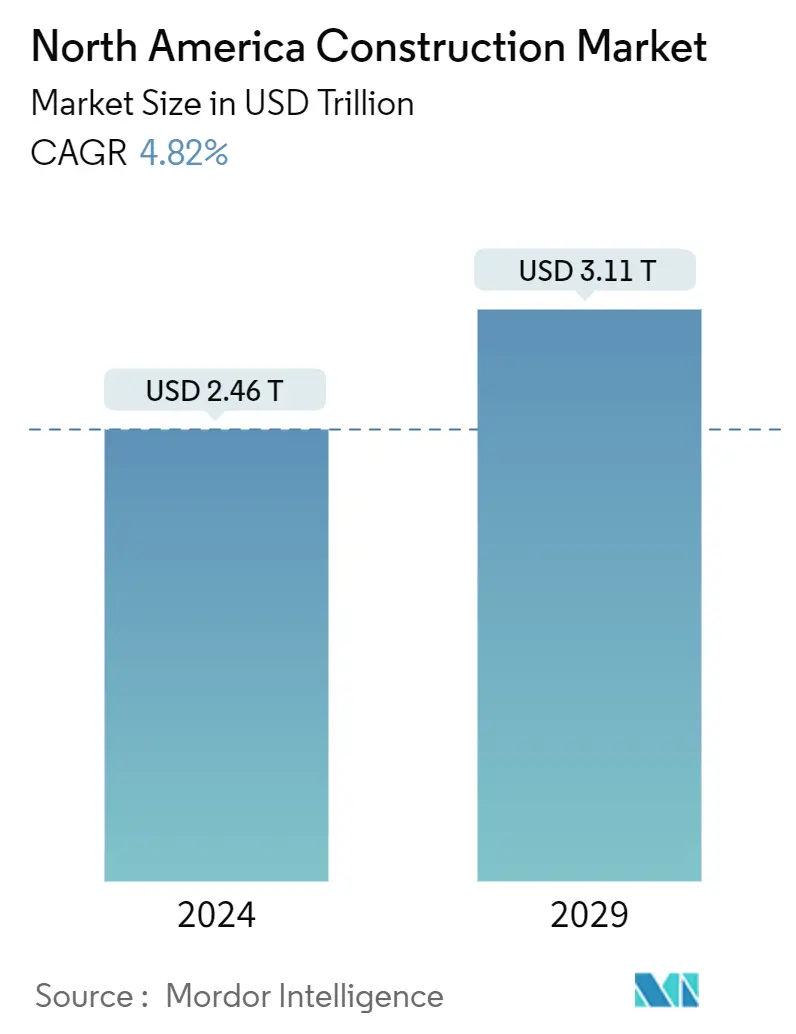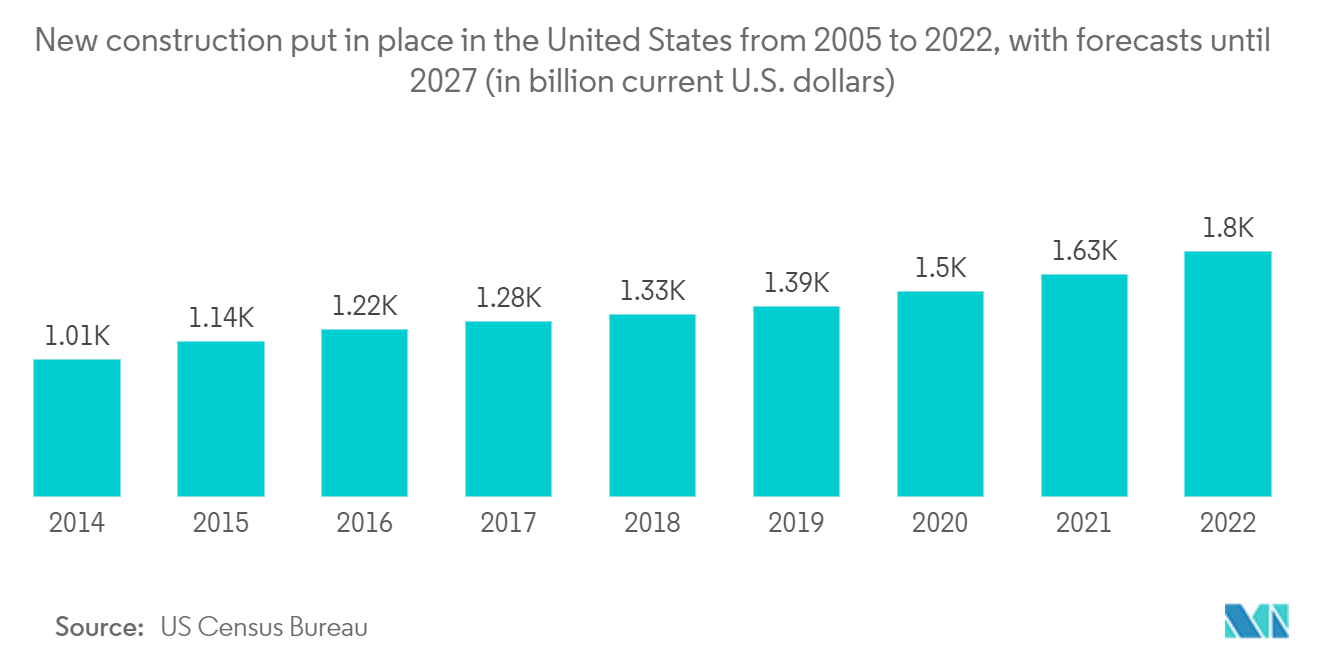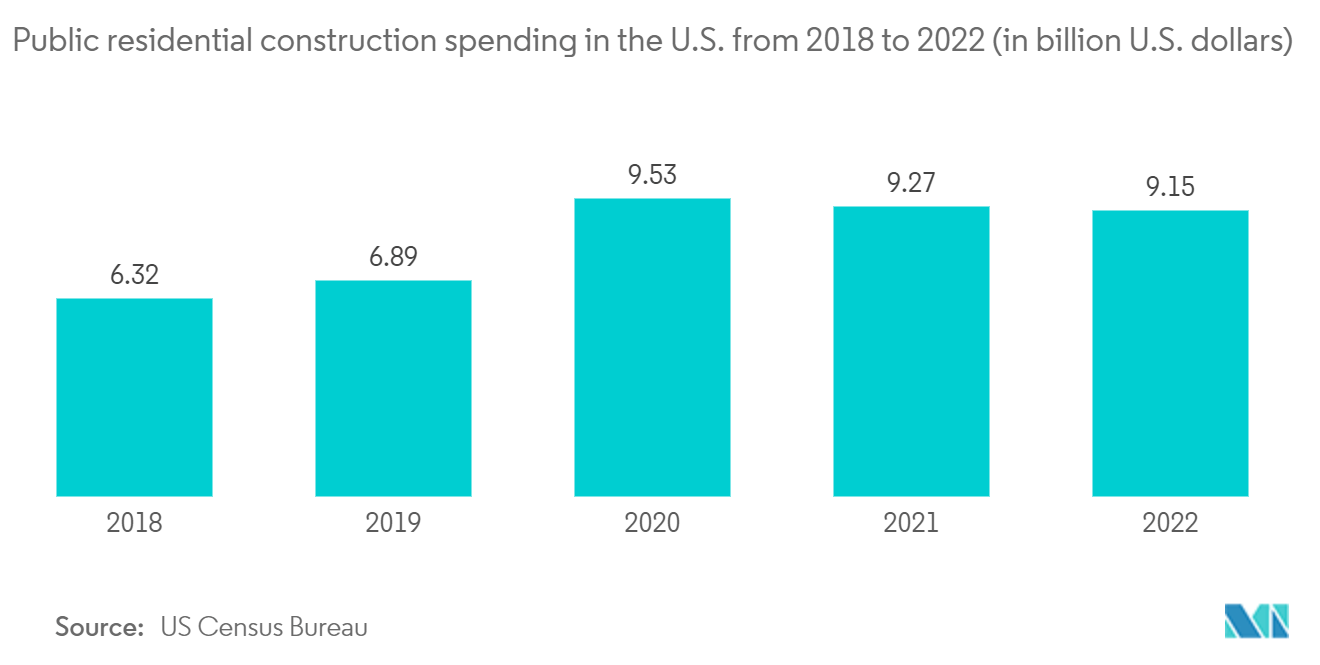North America Construction Market Size

| Study Period | 2019 - 2029 |
| Base Year For Estimation | 2023 |
| Market Size (2024) | USD 2.46 Trillion |
| Market Size (2029) | USD 3.11 Trillion |
| CAGR (2024 - 2029) | 4.82 % |
| Market Concentration | Low |
Major Players
*Disclaimer: Major Players sorted in no particular order |
Need a report that reflects how COVID-19 has impacted this market and its growth?
North America Construction Market Analysis
The North America Construction Market size is estimated at USD 2.46 trillion in 2024, and is expected to reach USD 3.11 trillion by 2029, growing at a CAGR of 4.82% during the forecast period (2024-2029).
- In 2023, the North American construction sector showcased resilience against a challenging backdrop of high interest rates, limited credit availability, and concerns over a potential financing crunch following US banking failures. Mexico emerged as the frontrunner, witnessing a notable surge primarily driven by heightened public infrastructure spending in anticipation of the Presidential election. Despite soaring mortgage rates in the United States, the scarcity of existing homes for sale bolstered demand for new homes. Government initiatives encouraging the return of manufacturing activities have propelled non-residential construction, outpacing the growth in residential construction.
- However, Canada faced a setback, with housing starts declining, primarily due to a slump in single-family home construction. On the other hand, non-residential construction gained momentum, buoyed by robust investments in industrial and institutional projects. Yet, the commercial segment, encompassing offices and retail, which constitutes half of the non-residential sector, witnessed a dip, currently down by approximately 3.5% YoY.
- The housing shortage is a big challenge in the United States. The National Association of Home Builders (NAHB) projects a 4.7% rise in single-family housing starts in the United States in 2024, followed by a further 4.2% uptick in 2025. These growth rates are expected to push the annual housing starts to a robust 1.3 million units by 2025. Despite facing headwinds, builders in the housing sector stand firm in their optimism, driven by a surge in consumer demand. A staggering 80% of builders are poised to commence construction on a greater number of homes this year. In addition, 51% of the builders anticipate a growth rate of over 10% in housing starts, surpassing the figures from 2023.
- For instance, in March 2023, The Governor and Mayor of New York City jointly launched the "Future Housing Initiative," a strategic collaboration that allocated USD 15 million to expedite the construction of 3,000 energy-efficient and all-electric affordable homes. This initiative marks a significant stride toward the targets set in the state's Climate Leadership and Community Protection Act, which aims to slash greenhouse gas emissions by 85% by 2050 and ensure that 35-40% of clean energy benefits reach underprivileged communities. The initiative aligns with New York City's green building objectives outlined in Local Law 97.
North America Construction Market Trends
Residential Construction Segment Holds the Major Share in the Market
- Residential construction, already reeling from rising mortgage rates, is expected to continue to contract and be joined by nonresidential construction as the commercial sector retrenches. The funds provided to the construction industry through the Infrastructure Investment and Jobs Act (IIJA), the CHIPS and Science Act, and the Inflation Reduction Act (IRA) will counter the downturn, allowing the construction industry to tread water.
- The US housing market has borne the brunt of the interest rate hikes amid efforts by the Federal Reserve (Fed) to tame inflation. The Fed announced its ninth straight interest rate hike of 25 basis points in March 2023. This move increased the federal funds rate from nearly 0% in March 2022 to a range of 4.75-5%. The Fed will likely hike rates further by 25 basis points in early May 2023, as the job market remains tight and inflation is still at higher levels despite easing in recent months.
- In July 2023, the US saw a substantial increase in construction spending due to a lack of housing available on the market, which led to higher expenditures for single-family residential projects. According to the Commerce Department, construction expenditure rose by 0.7%. To show that construction spending increased by 0.6% rather than 0.5%, as reported earlier, data for June 2023 have been revised up a little.
- In July 2023, construction expenditure increased by 5.5% year over year. Private construction spending increased by 1.0% after rising 1.5% in the previous month, while investment in residential buildings increased by 1.4%. In June, private building expenditure increased by 0.6%. In July, the spending on single-family housing projects jumped by 2.8%. A shortage of houses drives construction for sale, although higher mortgage interest rates could slow it down.
- As the market is currently expecting a cut in rates, housing construction will start to recover somewhat in Canada in 2024. However, for the next five years, residential construction is expected to decrease at an annualized rate of 1.1% and reach a value of USD 156.7 billion due to continued high overnight rates.

United States Expected to Witness Growth
- US construction output was forecast to contract by 5% in 2023 due to a slump in residential construction. Rising interest rates lead to higher project financing costs, while inflation has increased construction material costs. Lack of skilled workers and supply chain disruptions have led to longer lead times and project delays. In addition, an aging workforce could curtail potential construction output in the future.
- The residential building segment is expected to see the most significant contraction because aggressive monetary tightening is feeding into higher mortgage rates, and high inflation weighs on the affordability of homeownership. However, non-residential construction remains more resilient due to government stimulus. The Infrastructure Investment and Jobs Act is expected to stimulate construction, aiming at comprehensive investments in aging infrastructure (including roads, highways, bridges, rail, and broadband development).
- Construction activities in the US residential sector started on a weaker note in 2023, with the total value of construction put in place (measured in seasonally adjusted nominal terms) falling by 4.1% year-on-year (Y-o-Y) in the first two months of 2023. Due to the economic slowdown, subdued demand in residential construction, and rising pressure on margins, payment delays, and insolvencies were expected to increase. With high interest rates and a slowdown in activity, businesses with limited liquidity and elevated debt levels will face difficulties servicing their obligations.
- Given the more subdued credit management situation and business performance of the construction industry, the market outlook has been downgraded from “Good” to “Fair.” Privately‐owned housing units authorized by building permits in April 2023 were at a seasonally adjusted annual rate of 1,416,000. This is 1.5% below the revised March rate of 1,437,000 and 21.1% below the April 2022 rate of 1,795,000.
- Single‐family authorizations in April were at a rate of 855,000, 3.1% above the revised March figure of 829,000. Authorizations of units in buildings with five units or more were at a rate of 502,000 in April 2023. Privately owned housing started in April at a seasonally adjusted annual rate of 1,401,000. This is 2.2% (±11.9%) above the revised March estimate of 1,371,000 but is 22.3% (±8.7%) below the April 2022 rate of 1,803,000.
- Single‐family housing starts in April 2023 were at a rate of 846,000, 1.6% (±12.3%) above the revised March 2023 figure of 833,000. The April rate for units in buildings with five units or more was 542,000. Privately‐owned housing completions in April were at a seasonally adjusted annual rate of 1,375,000. This is 10.4% below the revised March 2023 estimate of 1,534,000 but is 1% above the April 2022 rate of 1,361,000. Single‐family housing completions in April were at a rate of 971,000, 6.5% below the revised March rate of 1,039,000. The April rate for units in buildings with five units or more was 400,000.

North America Construction Industry Overview
The North American construction market is less competitive, with major international players occupying a significant market share and leaving less scope for other small and medium-scale players. The North American construction market presents opportunities for growth during the forecast period, which is expected to drive market competition further. The growing infrastructure and construction investments in the region's large economies create ample opportunities for other players. With a few players holding a significant share, the North American construction market has a detectable level of consolidation.
North America Construction Market Leaders
Lennar Corporation
D. R. Horton Inc.
Kiewit Corporation
Hochteif USA Inc.
Hensel Phelps Construction Co.
*Disclaimer: Major Players sorted in no particular order

North America Construction Market News
- June 2023: AXA XL's North American construction insurance business launched the Sustainability Circle. It is a network comprising 21 leaders in the sustainable construction industry. The goal of the initiative is to assist clients achieve their sustainability goals and enhance their construction risk management efforts.
- April 2023: Greystar Real Estate Partners LLC (“Greystar”) opened its flagship manufacturing facility for its modular construction business, Modern Living Solutions (“MLS”), which focuses on attainable and sustainable housing. The milestone was met with a ribbon-cutting ceremony at the western Pennsylvania site where MLS employed 170 full-time employees to execute the ramp-up and operations of its first modular factory.
North America Construction Market Report - Table of Contents
1. INTRODUCTION
1.1 Study Assumptions
1.2 Scope of the Study
2. RESEARCH METHODOLOGY
3. EXECUTIVE SUMMARY
4. MARKET INSIGHTS
4.1 Current Economic and Construction Market Scenario
4.2 Technological Innovations in the Construction Sector
4.3 Impact of Government Regulations and Initiatives on the Industry
4.4 Review and Commentary on the Impact of Heavy Equipment Prices on the Construction Industry
4.5 Comparison of the Key Industry Metrics of North American Countries (Analyst View)
4.6 Comparison of Construction Cost Metrics of North American Countries (Analyst View)
4.7 Impact of COVID-19 on the Market
5. MARKET DYNAMICS
5.1 Market Drivers
5.1.1 Population Growth and Disposable Income
5.1.2 Demand from Office Sector Returning Post COVID-19
5.1.3 Non-residential Construction on Upward Trend
5.2 Market Restraints
5.2.1 Interests and Financing
5.2.2 Increase in Cost of Raw Materials
5.3 Market Opportunities
5.3.1 Green Building Initiatives
5.3.2 Technology Advancements
5.4 Industry Attractiveness - Porter's Five Forces Analysis
5.4.1 Bargaining Power of Suppliers
5.4.2 Bargaining Power of Buyers/Consumers
5.4.3 Threat of New Entrants
5.4.4 Threat of Substitute Products
5.4.5 Intensity of Competitive Rivalry
6. MARKET SEGMENTATION
6.1 By Country
6.1.1 Canada
6.1.2 United States
6.2 By Sector
6.2.1 Commercial Construction
6.2.2 Residential Construction
6.2.3 Industrial Construction
6.2.4 Infrastructure (Transportation) Construction
6.2.5 Energy and Utilities Construction
6.3 By Construction Type
6.3.1 Additions
6.3.2 Demolition and New Constructions
7. COMPETITIVE LANDSCAPE
7.1 Market Concentration Overview
7.2 Company Profiles
7.2.1 Lennar Corporation
7.2.2 D. R. Horton Inc.
7.2.3 Kiewit Corporation
7.2.4 Hochteif USA Inc.
7.2.5 Hensel Phelps Construction Co.
7.2.6 Tutor Perini Corporation
7.2.7 PulteGroup Inc.
7.2.8 The Whiting-Turner Contracting Company
7.2.9 Toll Brothers Inc.
7.2.10 NVR Inc.
7.2.11 Graham Income Trust
7.2.12 PCL Construction Group Inc.
7.2.13 SNC-Lavalin Construction Inc.
7.2.14 Aecon Group Inc.
7.2.15 Kajima U.S.A. Inc.*
- *List Not Exhaustive
8. FUTURE OF THE MARKET
9. APPENDIX
North America Construction Industry Segmentation
Construction is the installation, maintenance, and repair of buildings and other stationary structures. It includes the construction of roadways and service facilities that form fundamental components of structures and are required for their operation. Construction encompasses the processes involved in constructing buildings, infrastructure, industrial facilities, and related operations from start to finish.
The North American construction market is segmented by country (Canada and the United States), sector (commercial construction, residential construction, industrial construction, infrastructure (transportation) construction, and energy and utilities construction), and construction type (additions and demolition and new construction). The report offers market size and forecasts in value (USD) for all the above segments.
| By Country | |
| Canada | |
| United States |
| By Sector | |
| Commercial Construction | |
| Residential Construction | |
| Industrial Construction | |
| Infrastructure (Transportation) Construction | |
| Energy and Utilities Construction |
| By Construction Type | |
| Additions | |
| Demolition and New Constructions |
North America Construction Market Research FAQs
How big is the North America Construction Market?
The North America Construction Market size is expected to reach USD 2.46 trillion in 2024 and grow at a CAGR of 4.82% to reach USD 3.11 trillion by 2029.
What is the current North America Construction Market size?
In 2024, the North America Construction Market size is expected to reach USD 2.46 trillion.
Who are the key players in North America Construction Market?
Lennar Corporation, D. R. Horton Inc., Kiewit Corporation, Hochteif USA Inc. and Hensel Phelps Construction Co. are the major companies operating in the North America Construction Market.
What years does this North America Construction Market cover, and what was the market size in 2023?
In 2023, the North America Construction Market size was estimated at USD 2.34 trillion. The report covers the North America Construction Market historical market size for years: 2019, 2020, 2021, 2022 and 2023. The report also forecasts the North America Construction Market size for years: 2024, 2025, 2026, 2027, 2028 and 2029.
How is the North America Construction Market segmented based on sector?
Based on sector North America Construction Market is segmented by a) Commercial Construction b) Energy and Utilities Construction c) Industrial Construction d) Infrastructure Construction e) Institutional Construction, and Residential Construction
North America Construction Industry Report
The North America construction market is experiencing significant growth, driven by factors such as economic conditions, technological advancements, and regulatory frameworks. Key market segments include commercial construction, energy and utilities construction, industrial construction, infrastructure construction, institutional construction, and residential construction. The market is characterized by a dynamic ecosystem where economic trends, technological innovations, and regulatory shifts collectively propel its evolution. The construction industry in North America plays a crucial role in fostering economic growth, driving operational efficiency, and contributing to social development. The market is segmented by sector and country, with detailed analysis provided for each segment. The North America construction market size is poised for substantial expansion, driven by innovation, collaboration, and evolving market dynamics. The construction market in North America presents significant opportunities for investors. The US construction market size is a significant component of this growth, reflecting broader construction industry trends. Statistics for the North America construction market share, size, and revenue growth rate are created by Mordor Intelligence™ Industry Reports. North America construction analysis includes a market forecast outlook and historical overview. Get a sample of this industry analysis as a free report PDF download.
